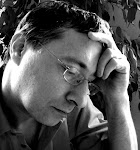Outside my window a small spider is trying to construct a web, a task made considerably harder by the buffeting wind. Watching it, I am struck by the thought that it can't see the pattern of the web that we are all used to. We look in form the outside on the finished item. It sits in the middle, so close that it can't see the whole thing.
How is it doing it and what has all this got to do with the construction of long fiction?
The parallel is clear enough. When you are working on a novel, you are too close to see the whole thing. Perhaps if I understood how the spider is doing it, I could figure out how to plot a novel!
All the spider needs to do is know the relative angles and spacings of threads. So long as those things are kept regular, the web will form its familiar pattern. Might it be possible to plot a novel using the same approach - simply seeing the detail of the chapter you are on at the time, using that to find out what must happen in the next chapter?
I think the answer is yes. In part. I have certainly met novelists who say they are very bad at plotting and follow the narrative drive of each scene to discover where the story should go. Raymond Chandler famously said that when he got stuck with a story he would have a man come through the door with a gun in his hand.
What is the starting state in the chapter? What is the ending state? Where and how does the change come about. What is a story but an account of a series of moments of change of escalating magnitude?
Having said all the above, the spider seems to have given up. Or perhaps he is resting. Or perhaps he's imagining how the whole web will look from a distance once it's finished.
Tuesday, July 14, 2009
Subscribe to:
Post Comments (Atom)

No comments:
Post a Comment